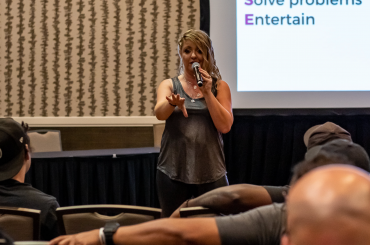Maybe you’re generating most of your DJ gigs through referrals. Or perhaps you’re generating many of them through bridal shows or Expos. Maybe you’re using direct mail.
Whatever the source of your bookings, it’s likely that you’re leaving money on the table if you’ve got a website that encourages people to leave.
Check for yourself. Go to your Google Analytics and see what your bounce rate is for your homepage. If it’s above 50-percent, it might be worth reading this article: Here are Five reasons why readers, or, rather, potential buyers, might be bouncing.
1) Your design is very 2005.
Outdated design is probably the chief reason why people are leaving your website before they ever get a chance to dive in.
On his blog “Social Triggers,” Derek Halpern cited a study that illustrates the importance of design to a user’s perception of the website—and its owner.
In the study, Dr. Elizabeth Sillence asked participants to review websites on the subject of hypertension. She then polled the participants on whether they trusted or distrusted the website. The study found that 94-percent of wary respondents attributed their uneasiness to the website’s design.
So, consider your web design, and a user’s confidence in your abilities, as bedfellows. If you haven’t updated your site in the last five years, it’s time to consider a re-design—or at least a tweaking.
2) Your navigation is like a labyrinth.
There are terms like “conversion path” that are thrown around, and “UX,” as well. But the only thing you need to worry about is this Website Taste Test: When a user visits your website, does every page have a distinct purpose? If not, it might be time to consider a website tweaking.
Also, do you take the reader through their “buyer’s journey”? In other words, is there a page that addresses the anxiety they might be feeling as they’re planning their wedding? (“Afraid that your wedding will be a bomb?” Or, “Tired of DJs who drag your party down?”).
And, then is there a logical place for the reader to go that offers a solution to their problem—your DJ service! And then, you’ll need another page that offers testimonials that your service is the real deal.
Too often, this “conversion path” is neglected, which encourages a user to leave your website.
3) Your content is difficult to read.
The fonts you use, as well as the colors of your text and background, can determine how easily people can read and digest the content on your website. In other words, if they can’t read your site, they can’t buy your service.
Follow these general guidelines to help you determine font selection:
#A. Choose fonts that are readable.
What makes a font easy to read? There are a number of contributing factors, and they’re typically broken down into two issues, Readability and Legibility.
Readability refers to the way in which words and blocks of type are arranged on a page. Legibility refers to how a typeface is designed and how well one individual character can be distinguished from another. It also refers to how well-defined the word shapes are.
Serif fonts are typically easier to read in body copy and have been used extensively for decades, which sometimes can give a book or website a more classic feel.
But due to the screen size and resolution that web content is often viewed from, many web designers favor sans serif fonts. These fonts are also preferred among designers with a more current feel.
#B. Use contrast to your advantage
A major component of a font’s readability is contrast, which is achieved by the use of space and color. Place dark text on a pale background; it provides the viewer a better reading experience for longer blocks of text. Reserve colored type for headlines and display text.
#C. Choose the proper font size
For multiple-line paragraphs, keep the size of your body font limited to 45-70 characters per line. More than 70 characters per line will tire readers as they scan back and forth and lose their place. Lines that are too short may cause awkward hyphenated breaks or, if justified, “rivers of whitespace running through paragraphs.”
4) Your site isn’t responsive.
What is responsive design? Simply, the ability for your website to be viewed seamlessly on multiple devices. So many people put so much emphasis on how their website looks on a PC or Mac screen and neglect mobile, which is how most people are viewing websites.
And, since Google’s mobile algorithm update arrived last year, if your site isn’t responsive to mobile devices, you’ll likely lose out significantly in the organic search rankings
You can’t afford to miss out on the traffic that a responsive designed site will enable. Seek a professional for this aspect of your re-design.
5) Your site lacks personality.
If only all DJs could translate their natural performing and music programming talents to their websites, there’d be no issue. Unfortunately, that’s not the case.
The reason is that DJs are not web designers. But you can take an active part in a re-design process. You can do this by simply showing your designer websites that you think have personality. This is a great way to arrive at your own design vocabulary. You like bold colors? Large imagery? Scrolling as opposed to a static homepage?
Make a note of it. The same way you perfected your stagecraft—knowing what not to do, editing yourself, and incorporating as much information about your clients to make their day special—is exactly what should be reflected in your website.
Happy tweaking!








